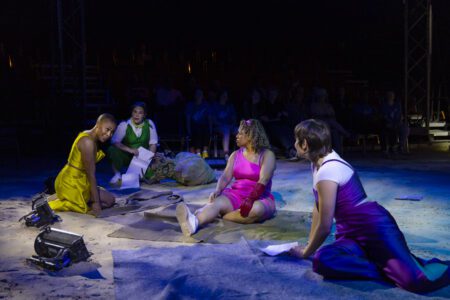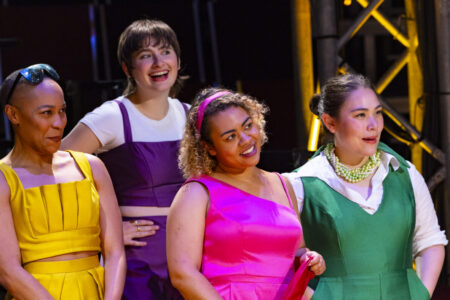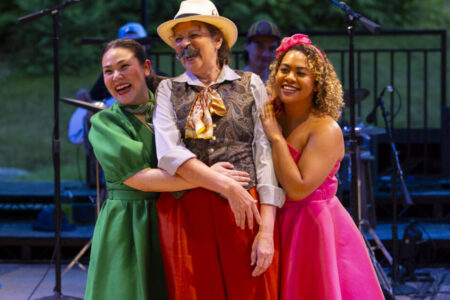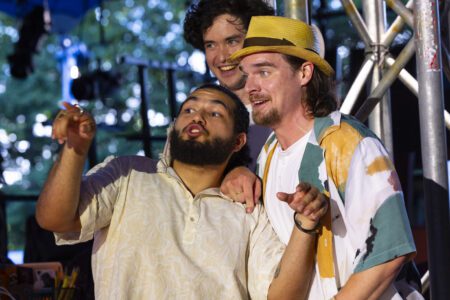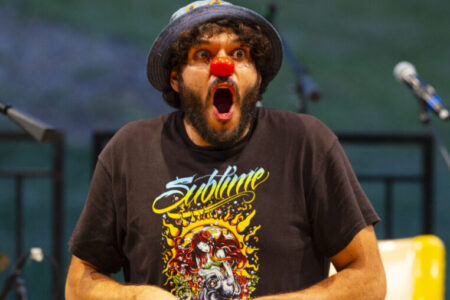Four young noblemen absent themselves from society, in order to focus entirely on their studies.
They even take a monastic oath: No girls! All books! But when the Princess of France turns up with three young ladies, how long will the men’s resolve hold up? Director Amanda Dehnert (2017’s PRIDE AND PREJUDICE) infuses Shakespeare’s delightful comedy with an original pop/rock score (by Dehnert and André Pluess) that gives full voice to the heart-pounding experience of being young and in love.
Buy Tickets
Story
In LOVE’S LABOR’S LOST, the comedy centers on four young men who fall in love against their wills. The men, one of them the king of Navarre, pledge to study for three years, avoiding all contact with women. When the Princess of France arrives on a state visit, the king insists she and her ladies camp outside the court. Even so, each young man falls in love with one of the ladies.
Meanwhile, Don Armado, a Spanish soldier, falls for a servant girl, Jacquenetta. Costard, an illiterate local, mixes up two letters he is to deliver, one from Armado to Jacquenetta and the other from Berowne, one of the king’s companions, to Rosaline, one of the French ladies.
The men confess they are in love, and devise a pageant for the ladies, who set a trap for them by exchanging identifying markers. When word comes that the princess’s father is dead, the ladies reject the men’s proposals as rash and impose a year’s delay before any further wooing.
Summary Courtesy of Folger Shakespeare Library.
Cast & Creative
Sir Nathaniel Duane Boutté*
Moth Timothy Bright
Dull Carl Howell*
Dumain Lennon Xin Wen Hu CC
The Princess of France Phoebe Lloyd CC
Jaquenetta Melissa Mahoney*
Holofernes Sean McNall*
Maria Emily Ota*
Longaville Francis Pàce-Nuñez CC
Costard Luis Quintero*
Sir Adrian O. Dearmaddow Kurt Rhoads*
Rosaline Antoinette Robinson*
Katharine Mayadevi Ross CC
Ferdinand, King of Navarre Omar Shafiuzzaman*
Berowne Stephen Michael Spencer*
Boyet Nance Williamson*
by William Shakespeare
Directed and adapted by Amanda Dehnert
Original music by Amanda Dehnert & André Pluess
Props Designer Buffy Cardoza
Costume Designer Jessica Shay
Sound Designer Ken Travis
Lighting Designer Reza Behjat
Voice Coach Alithea Phillips
Stage Manager Colt Luedtke*
Casting Calleri Jensen Davis (James Calleri, Erica Jensen, Paul Davis)
Key Art Ligature Creative
What to Expect
Romantic Mishaps
In this lively comedy, the King of Navarre and his three companions, Berowne, Dumaine and Longaville, commit to a life of study for three years. They swear off food, sleep — and women. Their oaths are tested when the Princess of France arrives with her three ladies-in-waiting, Rosaline, Katharine, and Maria. The lords fall in love with the ladies, and the King with the Princess.
Love is also in the air for country wench Jacquenetta, who attracts the attention of the clownish peasant Costard and Sir Adrian. Costard is given two letters to deliver: one from Adrian to Jacquenetta and one from Berowne to Rosaline, and the letters each end up with the wrong recipient.
The King and his lords eavesdrop on each other confessing their love for the Princess and her ladies, and when Berowne’s letter to Rosaline is revealed, the men decide to pursue the women. They plan to disguise themselves as Russians, but learning of the plan, the Princess and her ladies put on their own disguises to confuse their suitors. After the men leave and reappear as themselves, the women reveal their prank.
With all the secrecy, pranks, and switcheroos, Love’s Labor’s Lost really puts the antic in romantic.
Music
HVSF’s production of Love’s Labor’s Lost is a musical adaptation of the play, with an original pop/rock score by director Amanda Dehnert and Andre Pleuss, an award-winning sound designer and composer. The songs help set the stage and highlight the strong emotional currents running underneath the witty wordplay and bubbly comedy.
We’re always awe-struck by the talent of the HVSF company members, but seeing them find new depths of emotion by performing a musical incorporated into this wordy, rich play, we’re astounded anew at the way they light up the stage and draw the audience in.
A Play Within a Play
The play within a play — when characters in a play don costumes and put on a play themselves — is something of a hallmark in Shakespeare. They appear in works including Hamlet, A Midsummer Night’s Dream, and The Taming of the Shrew.
In Love’s Labor’s Lost, the King, the Princess, and their lords and ladies watch The Nine Worthies. We’re treated to Costard, Adrian, schoolteacher Holofernes, and others taking on the roles of Hector of Troy, Pompey the Great, Alexander the Great, Hercules, and Judas Maccabbaeus.
The play within a play turns the characters we have been watching into an audience themselves. In this case, the King, Princess, and their lords and ladies. It gives us a chance to enjoy a theatrical experience with them, and as they find the Pageant of the Nine Worthies uproarious, you’re sure to enjoy a good laugh in your seat as well.
A Happy Ending?
You’ve probably heard it said that all tragedies end in death, while all comedies end in marriage. But that’s not quite the case with Love’s Labor’s Lost, which ends in something of a cliffhanger.
During the performance of the Nine Worthies, a messenger comes to tell the Princess that her father has died. Upon hearing the news, the women put a temporary end to the men’s pursuit. They ask them to wait a year and a day, and if they prove faithful (and have grown up a little) the couples will reunite.
Despite it being a comedy, Love’s Labor’s Lost ends on a note of uncertainty. So… who wants to write a sequel?
Influences
The following is adapted from an article posted by Folger Shakespeare Library.
Love’s Labor’s Lost is one of three Shakespeare plays without a primary source (the others being A Midsummer Night’s Dream and The Tempest), but that doesn’t mean it was created in a vacuum. The below list explores some of the contemporary influences Shakespeare might have drawn on when writing this romantic comedy of scholarly pursuits upended by affairs of the heart.
The French academie: A guide by Peter de la Primaudaye
One of these is the The French academie, originally written in 1577 by Peter de la Primaudaye and later published in multiple English editions.
It’s not hard to see the parallels between this guide to ideal scholarly behavior, set in the form of a dialogue between four young gentleman, and Navarre’s “little academe.” Consider how The French academie recommends “sobrietie and frugalitie” as “We can not well vse our spirite . . . when we are stuffed with meate. Neither must we gratifie the belly and intrailes only, but also the honest ioy of the mind. For that which is contained in the other parts, pe∣risheth: but the soule separated from the body, abideth for euer.” This is echoed in Love’s Labor’s Lost when the men swear to “one day in a week to touch no food, / And but one meal on every day besides.”
The noble art of venerie or hunting: A guide by George Gascoigne
Act 4, Scene 1 of Love’s Labor’s Lost features the Princess and her ladies setting out on a hunt, which provides ample opportunity for jesting based around the hunter/prey relationship common to both shooting and wooing. Another royal, Queen Elizabeth I, was also fond of hunting and is depicted in illustrations from George Gascoigne’s 1575 guide to the sport (though her figure was changed for James by the time the 1611 edition was printed – see images below of the same page from multiple editions, with Elizabeth on the left and James on the right).
Alongside a catalogue of animals that can be hunted, Gascoigne’s guide also contains musical bugle calls, advice for the veterinary care of hunting dogs, and recommendations for how nobility should be entertained during such exercises, as is shown in a section entitled “Of the place where and howe an assembly should be made, in the presence of a Prince, or some honorable person.” The Folger owns multiple copies of this volume… including one specially bound in fur
The King of Navarre and Antonio Pérez
In addition to drawing from contemporary texts, Shakespeare is thought to have based a number of the characters on historical figures. There was a real King of Navarre (a region between Spain and France), Henry, who would later become France’s King Henry IV. He and the French courtiers Charles de Gontaut, duc de Biron; Charles, duc de Mayenne; and Henri I d’Orleans, duc de Longueville are likely reimagined as Ferdinand and friends in Shakespeare’s play.
Moreover, in the letter shown here, Robert Devereux (the Earl of Essex and a favorite of Queen Elizabeth I until she had him beheaded for treason) seeks to introduce Antonio Pérez to Prince Maurice of Nassau. Pérez was a flamboyant courtier and secretary to King Philip II of Spain. However, Pérez was forced to flee Spain in 1591 due to his involvement in the murder of Juan de Escobedo, a double-crossing court spy. In 1593 he came to England, where he joined Essex’s circle, and it is thought that he is the contemporary inspiration for the character of Don Armado in Love’s Labor’s Lost.
Catherine de Medici
Finally, some scholars speculate that the arrival of the Princess and her women (and what follows) was inspired by diplomatic missions undertaken by Catherine de Medici. The first of these occurred in 1578, when France’s then-Queen-Mother met with Henry to negotiate issues regarding the dowry of her daughter, Marguerite de Valois, whom Henry had married in 1572. Catherine was accompanied by Marguerite and the court’s “flying squadron,” a group of about 80 beautiful women whose charms were deployed for political ends. While the negotiations were eventually unsuccessful (Catherine would try to negotiate again in 1586), the entertainments of this meeting were lavish and likely known to the English through pamphlet literature.
While not directly related to the aforementioned ambassadorial trip, this letter, thought to be written by Catherine to her “good cousin” Margherita Paleologa, comes from a collection of Margherita’s papers related to her own dealings with important French political players, including the King of Navarre.
Reviews
The New Yorker: The Hudson Valley Shakespeare’s mounting of this early comedy from the Bard is an ecstatic success. It can be a difficult play to parse, with reams of contemporary in-jokes, complicated locutions, ancient politics, and antique moralizing. The director, Amanda Dehnert, doesn’t stint on the wordplay—indeed, the parody of poetical forms and of pedantry (the plot concerns a young king and three courtiers vainly vowing to eschew wine and women in dedication to academic pursuit) are at the heart of the comedy. But she also gives the talented cast of sixteen plenty of opportunity for inventive, hilarious stage business. Plus, Dehnert has co-written, with André Pluess, a set of terrific rock and pop songs which punctuate the action, abstractly distilling the characters’ emotions. Adding to the musicality, much of the play’s poetry is in rhymed couplets, perfect for working into hip-hop beats, and for skillfully deflating the male ego. There are four pairs of lovers—actually, five, maybe five and half, but who’s counting? It’s all grist for the comedic mill, the talent of the company, and the verbal brilliance of William Shakespeare. – Ken Marks
Q & A
How long is the show?
This production, including a 10-minute intermission, runs approximately 2 hours, 40 minutes (7:30pm – 10:10pm).
Is this show appropriate for children?
We encourage families to bring kids to HVSF. Love’s Labor’s Lost does make reference to sex, and a minor plot point involves an unmarried couple navigating a pregnancy. Although every family’s tolerance for grown-up themes is different, we believe this production is appropriate for older children. Little ones under 5 are not permitted under the tent.

Let us once lose our oaths to find ourselves, Or else we lose ourselves to keep our oaths.
Lord Berowne, Love's Labor's Lost
Buy Tickets
Please be sure to review your performance dates and seat locations before finalizing your order below. Ready to book more dates? Back to Calendar.
CAST

Duane Boutté*
Archbishop of Canterbury, The King of France, Erpingham (Henry V) and Sir Nathaniel (Love’s Labor’s Lost)

Timothy Bright (CC)
Cambridge, Bedford (Henry V) and Moth (Love’s Labor’s Lost)

Carl Howell*
Nym, Constable, Williams (Henry V) and Dull (Love’s Labor’s Lost)

Lennon Xin Wen Hu (CC)
Gloucester, Orleans (Henry V) and Dumain (Love’s Labor’s Lost)

Phoebe Lloyd (CC)
French Ambassador, Court, York (Henry V) and The Princess of France (Love’s Labor’s Lost)

Melissa Mahoney*
Montjoy, Hostess Quickly, Jamy (Henry V) and Jaquanetta (Love’s Labor’s Lost)

Sean McNall*
Sheppard (Ackroyd)

Emily Ota*
King Henry (Henry V) and Maria (Love’s Labor’s Lost)

Francis Pàce-Nuñez (CC)
Bardolph, Bates, Salisbury (Henry V) and Longaville (Love’s Labor’s Lost)

Luis Quintero*
Chorus Leader/Playwright (Medea) & Ensemble 2 (Queen)

Kurt Rhoads*
Exeter, Monsieur Le Fer (Henry V) and Sir Adrian O. Dearmaddow (Love’s Labor’s Lost)

Antoinette Robinson
King Henry Understudy (Henry V) and Rosaline (Love’s Labor’s Lost)

Mayadevi Ross CC (CC)
Grey, Governor of Harfleur, Queen of France (Henry V) and Katharine (Love’s Labor’s Lost)

Omar Shafiuzzaman*
Westmoreland, Gower, Princess Katherine (Henry V) and Ferdinand, King of Navarre (Love’s Labor’s Lost)

Stephen Michael Spencer*
Scroop, Dauphin, Macmorris (Henry V) and Berowne (Love’s Labor’s Lost)



